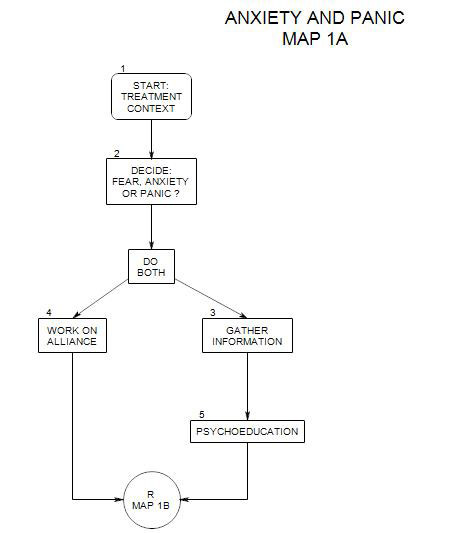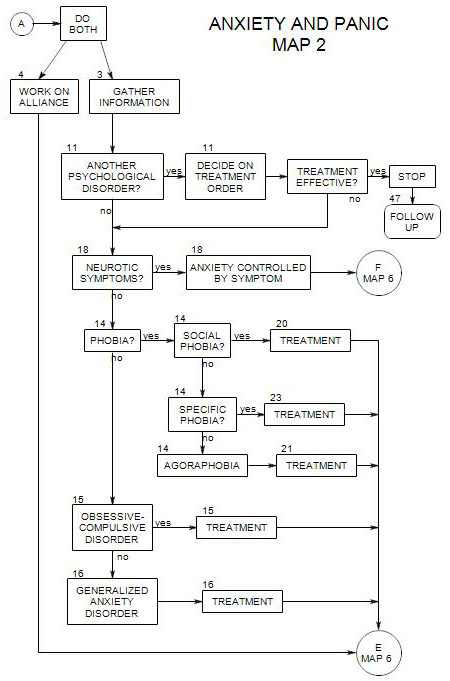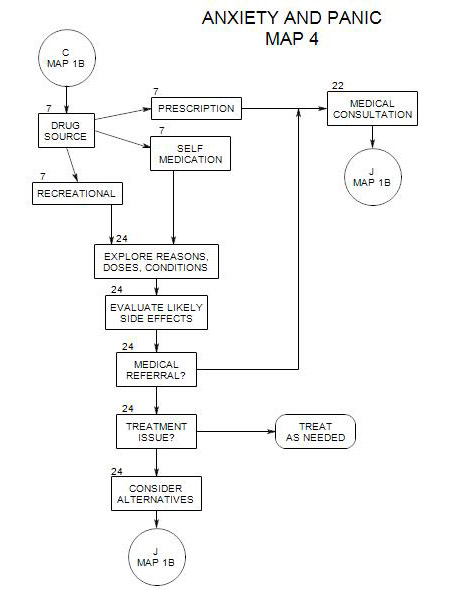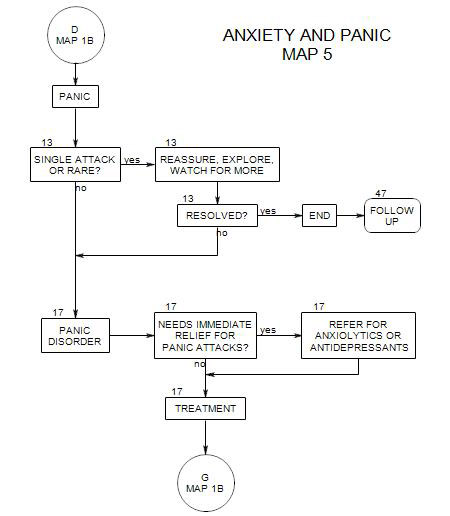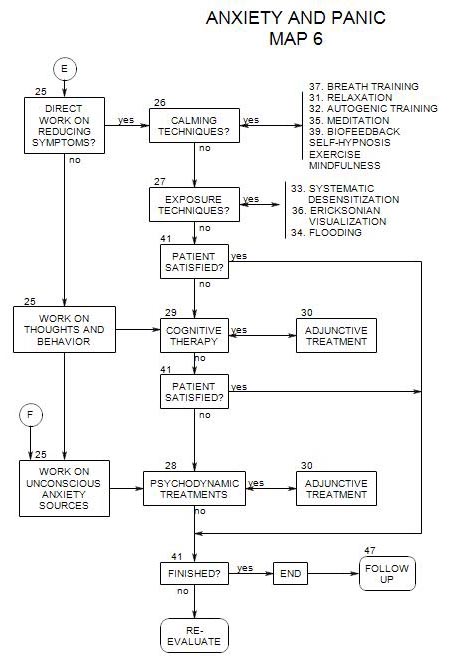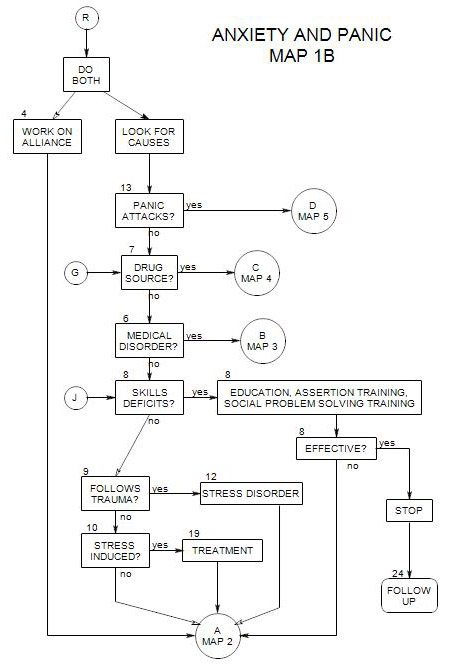
SECTIONS: 4 | 6 | 7 | 8 | 9 | 10 | 12 | 13 | 19 | 24
-
Follows Section 26 on Map 6
There are many ways to relax. A therapist’s job includes helping the patient find a way that is comfortable, meaningful, helpful and easy to do. As with a new exercise program, the method needs to be started in a way that the person will actually do it and continue doing it outside of the treatment setting. The general notion is for the patient to be able to create moments of calm as a matter of choice or plan, and then be able to use them to manage intrusive anxiety.
31a. Using Relaxation
Therapy sessions can be used to explore the methods of relaxing that can be effective for the patient. See also Section 25 on choice of overall approach and Section 26 on the choice among calming techniques.
There needs to be a training period in which the patient learns the chosen technique and how to call upon it as needed to manage anxiety.
Finally, it needs to be integrated into the person’s life. How this is done depends on the person’s need. If the anxiety is episodic, then it may be useful for him/her to relax before one of the anticipated episodes. If the anxiety is chronic, then regular relaxation may need to be part of the person’s daily routine.
31b. The Patient’s Repertoire
One possibility is that the person already has ways of relaxing that are relatively effective. Perhaps you can help him/her expand on those, or modify them to be more benign.
For example, a patient who drinks to unwind at the end of every day might be willing to explore the other components of unwinding, such as sitting in a favorite chair and remembering a calmer time. Such a person might be willing to experiment with the non-alcoholic part of the experience and try it regularly at another time of day.
Another patient may enjoy listening to music. He/she might be willing to set aside part of each day to listen to his/her favorite music, without doing anything else.
31c. Visual Imagery
Many people can think of relaxing images – of places they have been or would like to be, scenes they have seen in the movies or on television, etc. See if the person can generate that image in the treatment setting, and if so, return to it at will during the day.
You can suggest relaxing scenes to get the person started, such as
- Lying on the beach in the warm sun, listening to the waves or the children playing and watching the clouds go by overhead.
- Walking through the woods on a spring day, smelling the trees and hearing the birds.
- Sitting on the roof of an apartment building and watching the sun set over the city.
Sometimes a little humor can be helpful. “I knew a guy who was very good at dealing with tension. He would imagine himself lying on a recliner in a small boat in the middle of Nantucket Sound, the land far away, the boat rocking gently, and he would be at peace. Unfortunately he was a salesman of marine supplies, and he would often generate this image when dealing with customers. The bad thing was that he angered some customers and lost some sales. The good thing was that he worked for his brother-in-law, and didn’t get fired – he only got yelled at from time to time. And he only got a little anxious when his brother-in-law yelled at him.”
31d. Guided Imagery
Here the therapist takes the patient through a set of images designed to be relaxing, with the suggestion that the series is working.
For example, “You are standing on an escalator that is going down to the subway. You watch the walls go by on both sides. As you go down you are getting more and more calm and relaxed. More and more relaxed. Then you arrive at the platform, fully relaxed.’
There are other examples of these images in books on hypnotic induction techniques.
31e. Relaxation Tapes
There are many commercial CD’s available that have guided imagery bands or relaxing music.
31f. Progressive Relaxation
This approach involves teaching patients awareness of their own muscle tension and how to eliminate it. Emotional tension is consistently associated with muscle tension, so that by eliminating muscle tension, one is able to partly reduce emotional tension as well (Lehrer and Carr, 1997, pp. 83-84). The patient is actively engaged in doing something and in focusing his/her attention.
In the basic procedure, the person is taught to relax his/her muscles, group-by-group. Training can occur once, with the patient expected to continue at home; or it can be repeated as many times in session as needed.
It is often difficult for anxious people just to relax. In fact, they probably have tried that many times. So you can present it as a somewhat paradoxical task: “In order to relax effectively, you have to tighten-up first. It gives you control over the relaxation process, and it helps you relax more completely.”
Begin by having the person sit or lie comfortably, so when he/she is fully relaxed, the chair or floor will fully support him/her.
Then begin with a specific group of muscles. For this example, start with the person’s right foot. Ask the person to tighten the foot muscles, really tight, and hold that for a few – say, five – seconds. Try not to tighten any other muscles, if possible. Then relax those muscles, and feel them relax. Feel them get more relaxed than they were before starting. This part should take longer – 20 to 30 seconds.
Take a few seconds to ask how it went: Was the person able to hold it? Does the right foot feel more relaxed? Then repeat the same procedure, with the right foot again. All the while, the rest of the person’s body should remain as relaxed as possible.
Then, take other muscle groups in order, in each case first tightening and then relaxing the muscles, and repeating the process twice:
- Right calf and foot
- Right leg. Here, it may be helpful to raise the entire leg and hold it out stiffly.
- Left foot
- Left calf and foot
- Left leg
- Buttox and groin
- Stomach or abdomen. It may help to exhale here, or to imagine the abdominal muscles to be stiff and boardlike.
- Chest. Taking in a breath and holding it can be helpful. The relaxation phase includes letting the breath come in and go out slowly and easily.
- Right hand
- Right hand and forearm
- Right arm. The arm can be held up and out.
- Left hand
- Left hand and forearm
- Left arm
- Shoulders
- Neck and head
- Face. Here, it can be helpful to squeeze the eyes shut and pinch the facial muscles together.
At the end, ask how the person feels.
For other scripts, see
- Robertson, Donald. “Progressive relaxation” at www.ukhypnosis.com, or
- Guidetopsychology.com, or
- rci.rutgers.edu
31g. Another General Procedure(Lehrer and Carr, 1997):
- Patients are taught to relax specific muscle groups by becoming more aware of them and more sensitive to tension in them.
- Each session focuses on one muscle group
- Patients are expected to practice at home.
